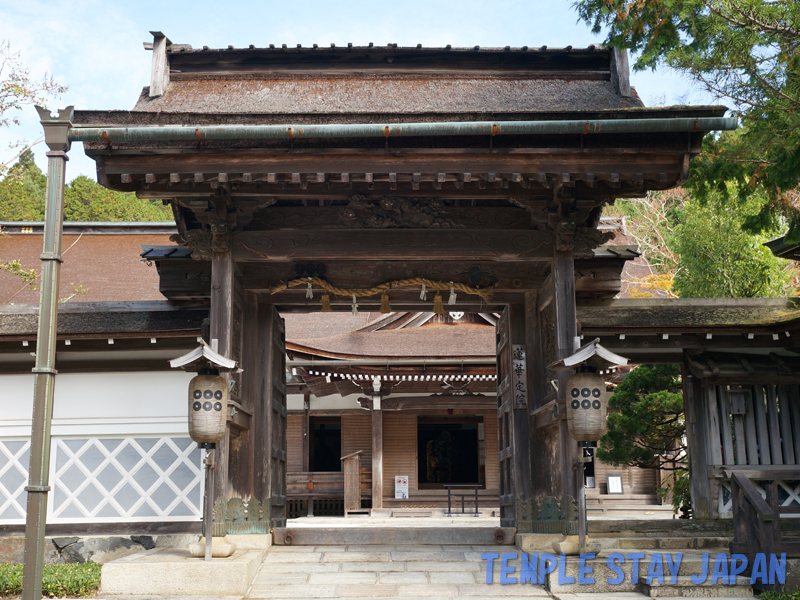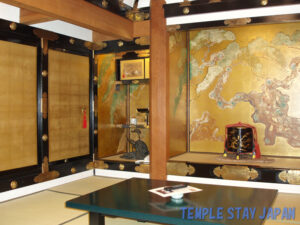Rengezyoin where Yukimura Sanada lived
This is the shukubo where Yukimura Sanada lived with his family. Sanada was a warrior who played an important role in the Battle in Sekigahara and Summer and Winter Battles in Osaka, which became turning points in Japanese history. (Yukimura Sanada had been in exile on Mount Koya once after the Battle in Sekigahara.)
In the entrance, a lantern on which the Rokumonsen coin, his family crest, was painted is hung. This family crest is marked on the ornaments and furniture/fixture used in the shukubo .
The room Yukimura Sanada stayed in is preserved as the Jodan-no-ma (upstairs’ room), along with his belongings and is open to general public. (Although the room once burnt down, the basic construction is left as it was.)
A lantern with the Rokumonsen crest is hung from the gate of the shukubo. So, upon stepping in the shukubo, I felt as if I had flown to the period of Masayuki Sanada and his son Yukimura. The crest is painted on the sliding screens as well.
Historical room
While I was being guided to the guestroom, I saw the Jodan-no-Ma where Sanada family lived. We were served meals in this historical room surrounded by classical paintings on sliding screens and artistic transoms. It was very much like the room of a lord.
During the meal, student priests from Koyasan High School and University wait on you. Their movements are quick and efficient, which was very pleasant. (This is not limited to Rengezyoin, but I feel this way whenever I stay on Mount Koya.) I reflected upon myself.
Furthermore, the host and the hostess told us a story about Mount Koya and the shukubo and introduced the student priests working there. I became fonder of the shukubo .
Dinner (shojin vegetarian food)
They served shojin vegetarian food. The Goma tofu, which is the specialty of Mount Koya, was pure white and the taste is lighter than any other. You can cut it smoothly with your chopsticks.
The cooked Koya-tofu was juicy and with one bite, tasty soup fills your mouth. Shojin tempura with green powder salt and somen noodles with mountain vegetables, a hotpot of Chinese cabbage, yuba (tofu skin) and ginkgo nuts, soup, pickles, devil’s tongue and millet gluten to be eaten with vinegar miso sauce, and mountain vegetables with ground yams, etc., were also included. It tasted simple but was good and the volume was certainly satisfactory as well.
What is more, jelly made from seaweed gelatin was served for dessert and it was really tasty.
Religious service
In the morning and in the evening, there is a religious service in the main hall.
Meditation practice was conducted from 17:30 in the evening. When I participated, there was not much explanation. It starts abruptly and then, only quiet time passed. After it was over, the priest explained the meditation method, so it was a little difficult to understand. However, you are able to spend precious time in the dimly-lit main hall.
As for the morning service, sutra are chanted and incense is offered. When I stayed there, it was in the middle of consecutive holidays in May, so the small main hall was filled with people.
Guest room
The room I stayed in consisted of two spaces, a 4.5 tatami mat section and a 6 tatami mat section. The room is equipped with a TV set, a kotatsu heater and an air conditioner. A yukata robe, a towel and a toothbrush were provided.
The room was connected with the corridor with a sliding screen and it is only possible to lock the room from the inside.
The priest is good at English
The people at the shukubo were all very kind. When I lost something, they all responded politely.
Also, the priest here is famous for his good command of English. Not only does the head priest give sermons in English, but the student priests there as well respond to the foreign guests in English. According to them, they learn English because many foreign guests come to stay at this shukubo.
Without mentioning, such an environment serves favorably, but I also felt their good personality in their effort to cope with foreign guests one by one in English.
Booking Link
Rengezyoin booking website










